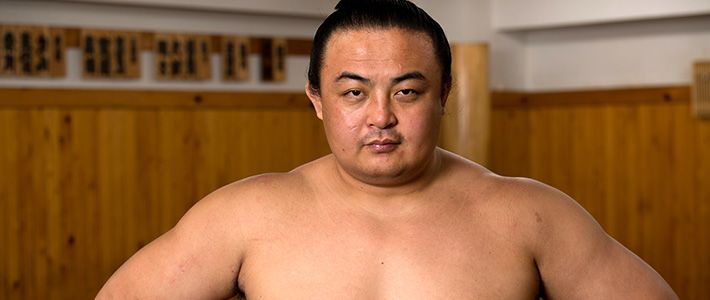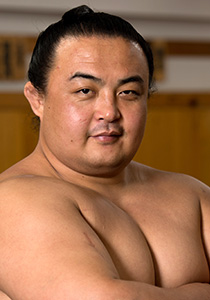
Building Bridges Between Japan and China
Chinese Sumō Wrestler Bounces Back into the Ring
Culture Lifestyle- English
- 日本語
- 简体字
- 繁體字
- Français
- Español
- العربية
- Русский
Making It Big in Sumō
 Boards bearing the name of Sōkokurai and other wrestlers belonging to the Arashio sumō stable.
Boards bearing the name of Sōkokurai and other wrestlers belonging to the Arashio sumō stable.
Reaching the top as a sumō wrestler, or rikishi, is extremely hard. Just 647 rikishi are currently active in the professional ranks according to the official banzuke listing of wrestlers for the May 2014 Grand Sumō Tournament. And a rikishi enters even more exclusive company if he performs well enough for promotion to the top division, makuuchi—made up of a mere 42 wrestlers.
The rikishi Sōkokurai joined that rarified company following a stellar performance at the September 2010 Grand Sumō Tournament, becoming the first Chinese wrestler to do so. This followed quickly after his promotion in January of that same year to the second highest division, jūryō. The wrestlers in those top two divisions are referred to by the honorific title sekitori, and when Sōkokurai earned that title the Japanese media described him as the “the first Chinese sekitori in 36 years.” This was a reference to the fact that an ethnically Chinese rikishi, Kiyonohana, was promoted to jūryō back in 1974. But, although his parents were Chinese, Kiyonohana was born and raised in Osaka. This means that Sōkokurai is in fact the first rikishi born in China to become a sekitori.
No Train, No Gain
Things get started very early at the Arashio “sumō stable,” or heya, in Tokyo’s Chūō Ward, to which Sōkokurai belongs. Training usually begins at 6:30 and wraps up at around 10:00. By the time we arrive at the stable, around eight in the morning, the wrestlers at the first-floor practice ring are already slick with sweat from their practice bouts.
About 20 wrestlers take part in this particular training session. The room reverberates with piercing cracks from the head-on collisions between the enormous men and the thundering sound of young rikishi being thrown to the sandy surface of the ring. The winner of each bout stays in the ring to fight the next opponent, in a punishing practice routine known as mōshiai. A procession of defeated wrestlers return to the ringside to await their next turn, panting heavily from the exertion.
When we got a chance to speak to Sōkokurai later, we asked him if the legions of pampered “little emperors” produced by China’s one-child policy might struggle to cope with such grueling drills. “If you really want to succeed,” he said after a brief pause, “this rigorous training is a must. Training like this is what makes you an adult—and that’s true whether you are in Japan or in China.”
Setting Foot in the Sumō World
Sōkokurai first came to Japan from the Chinese region of Inner Mongolia when he was only 19 years old. He was born in the city of Chifeng, and went by the name of Enhetubuxin until entering sumō. “I started wrestling in China,” he explains, “but after hearing about sumō, I wanted to become a rikishi. At first, my parents didn’t approve, but in the end they said they couldn’t stand in the way of my dreams and gave me their consent.”
Enhetubuxin’s chance to enter the sumō world came in April 2003, when the Arashio stable master Ōyutaka Masachika visited China in search of a sumō apprentice. At first, Ōyutaka had his mind set on recruiting another Chinese candidate, a powerfully built young man, but the negotiations stalled. Just when Ōyutaka was planning to cut his losses and return to Japan, Enhetubuxin paid a visit to the stable master’s hotel to volunteer his services. Ōyutaka agreed to give the young man a chance, and in June of that year Enhetubuxin travelled to Japan to become an official member of the stable. Under his new sumō name, Sōkokurai, he took to the ring for his first competitive match the following September. But the road ahead would be far from smooth.
A Setback—and a Comeback
“I struggled to build up my weight at first because I couldn’t get used to Japanese cuisine.” Sōkokurai recalls. “Even getting through a single bowl full of food was a chore; at times I literally had to force it down. But now I love the food here—even nattō!”
Despite the hardships he encountered, Sōkokurai looks back on those early days with a certain sense of nostalgia. The Arashio stable was relatively new at the time the Chinese wrestler joined. For a while it only had one other rikishi besides Sōkokurai. The two often had to travel to other stables to find practice partners. On top of this, Sōkokurai suffered for a while from a duodenal ulcer that forced him down in the rankings. But Sōkokurai kept working at his sumō, under the close instruction of his stable master, and began to steadily climb the ladder.
 Then, in 2011, unexpected disaster struck: Sōkokurai was accused of involvement in a high-profile match-fixing scandal. In April of that year he was found guilty by the Japan Sumō Association and ordered to retire from the sport. But Sōkokurai, knowing himself to be innocent, refused to give in so easily. With the support of his stable master and many others, he challenged this ruling in the courts. When his dismissal was finally overruled in March 2013, he was allowed to return to the ring.
Then, in 2011, unexpected disaster struck: Sōkokurai was accused of involvement in a high-profile match-fixing scandal. In April of that year he was found guilty by the Japan Sumō Association and ordered to retire from the sport. But Sōkokurai, knowing himself to be innocent, refused to give in so easily. With the support of his stable master and many others, he challenged this ruling in the courts. When his dismissal was finally overruled in March 2013, he was allowed to return to the ring.
“It was a very difficult time.” Sōkokurai explains. “A two-year absence from competition is like a death blow for a rikishi. After my comeback, I went on a losing streak and dropped all the way back down to jūryō.”
But Sōkokurai did not give up. And he says that he is incredibly grateful for the tremendous support he received from people in both China and Japan.
Learning by Doing
Over the decade or so of living in Japan, Sōkokurai has become quite fluent in Japanese. But he humbly attributes this ability to his involvement in the sport he loves. “Sumō is a tough world, and you won’t survive in it if you don’t remember everything you are taught, day in and day out. We foreign wrestlers don’t learn the language with pen and paper, but with our whole bodies, every day at practice.” Keen to share his experience of studying Japanese with others, he has even given a talk on the topic at prestigious Waseda University.
Sōkokurai got married four years ago to a woman from his hometown of Chifeng, where his parents and two sisters still live. He and his spouse plan to take a short trip home after the May tournament, but you can be sure Sōkokurai will be back soon, refreshed and ready for more hard work.
(Originally written in Japanese. With thanks to the Arashio stable and the Japan Sumō Association. Photographs by Kodera Kei.)













